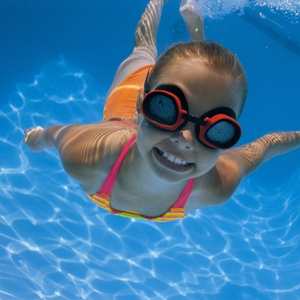What are the risks of swimming in chlorinated pools? What precautions can parents of avid swimmers take to reduce the risk of chlorine-associated health problems?
As a former world champion swimmer, my opinion of swimming is biased. I have first-hand experience of the incredible physical and mental health benefits of growing up as a swimmer. I’ve also loved swimming with my kiddos from the time they were babies. For us, it is a time for bonding, exercising regularly, and making fun memories.
When I first heard that swimming in chlorinated pools is risky for health, I didn’t want to believe it. However, research has been building during the past two decades, showing that chlorinated pools may have a harmful impact on health.
At this time, I firmly believe that for most people the benefits of swimming outweigh the risks of chlorine. With that being said, it’s important to be aware of the risks so that you can take steps to mitigate them.
Health Risks Associated With Swimming In Chlorinated Pools
Chlorine is used as a disinfectant in pools. When it mixes with compounds in sweat and/or urine it produces chemicals, called chloramines, which seem to be the main culprits contributing to chlorine’s negative effects.
Risks appear to be highest in small infants with sensitive skin and developing lungs; however, people of all ages are vulnerable to the effects of chlorine. The number of hours that people spend in and around chlorinated pools increases their risk of the following adverse effects:
- Skin & eye irritation & eczema
- Lung irritation & asthma
- Increase in hayfever & allergies
- Possible increase in risk of bladder & rectal cancer
- Possible increase in cardiovascular disease
Strategies To Reduce Negative Health Impacts Of Chlorine
1. Rinse before and after swimming
Rinsing before swimming removes sweat, which can mix with chlorine and create harmful chloramines. Rinsing after swimming with a gentle cleanser removes chlorine from skin and hair to reduce possible skin irritation.
2. Apply moisturizer after swimming
Chlorinated pools can strip moisture from the skin. Applying a natural moisturizer after swimming can help keep skin healthy and reduce irritation. We prefer Cleanest Care Nourishing Body Lotion.
3. Supplement with antioxidants like vitamin C
Supplementing with antioxidants in general and vitamin C, in particular, can help prevent damage associated with chlorine-mediated glutathione depletion, especially in the lungs.
4. Support healthy immune balance
Supporting a healthy immune balance may reduce the likelihood of developing allergies, asthma, and eczema. My top choices for immune balance include medicinal mushrooms, probiotics, and vitamin D.
5. Look for alternatives to chlorination
Disinfection is important to keep pools clean and safe to swim in. However, chlorination isn’t the only disinfection option. Saltwater systems, ozonation, ionization, and other strategies can reduce or eliminate the need for chlorine while keeping water safe and clean.
6. Choose outdoor pools when possible
Outdoor pools have better air circulation which reduces the amount of harmful chemicals that can be inhaled.
Summary
Swimming is a great choice of physical activity for kids and adults alike. However, chlorinated pools can irritate the skin and lungs and are associated with an increase in allergic diseases like asthma, eczema, and hay fever.
Good pool habits like showering before and after swimming and keeping skin moisturized and healthy can reduce the risks of swimming in chlorinated pools. Choosing outdoor pools and/or pools that use alternative methods of disinfection can further reduce the risks.
Supplemental products to help mitigate risks include vitamin C, vitamin D, probiotics, and medicinal mushrooms, which provide antioxidants, replenish glutathione, and promote immune balance.
References:
Li JH, Wang ZH, Zhu XJ, Deng ZH, Cai CX, Qiu LQ, Chen W, Lin YJ. Health effects from swimming training in chlorinated pools and the corresponding metabolic stress pathways. PLoS One. 2015 Mar 5;10(3):e0119241. doi: 10.1371/journal.pone.0119241. PMID: 25742134; PMCID: PMC4351252.
Fanucchi, M. V., Bracher, A., Doran, S. F., Squadrito, G. L., Fernandez, S., Postlethwait, E. M., Bowen, L., & Matalon, S. (2012). Post-exposure antioxidant treatment in rats decreases airway hyperplasia and hyperreactivity due to chlorine inhalation. American journal of respiratory cell and molecular biology, 46(5), 599–606. https://doi.org/10.1165/rcmb.2011-0196OC
Yadav, A. K., Bracher, A., Doran, S. F., Leustik, M., Squadrito, G. L., Postlethwait, E. M., & Matalon, S. (2010). Mechanisms and modification of chlorine-induced lung injury in animals. Proceedings of the American Thoracic Society, 7(4), 278–283. https://doi.org/10.1513/pats.201001-009SM
Leustik, M., Doran, S., Bracher, A., Williams, S., Squadrito, G. L., Schoeb, T. R., Postlethwait, E., & Matalon, S. (2008). Mitigation of chlorine-induced lung injury by low-molecular-weight antioxidants. American journal of physiology. Lung cellular and molecular physiology, 295(5), L733–L743. https://doi.org/10.1152/ajplung.90240.2008
Hoyle G. W. (2010). Mitigation of chlorine lung injury by increasing cyclic AMP levels. Proceedings of the American Thoracic Society, 7(4), 284–289. https://doi.org/10.1513/pats.201001-002SM
van Veldhoven, K., Keski-Rahkonen, P., Barupal, D. K., Villanueva, C. M., Font-Ribera, L., Scalbert, A., Bodinier, B., Grimalt, J. O., Zwiener, C., Vlaanderen, J., Portengen, L., Vermeulen, R., Vineis, P., Chadeau-Hyam, M., & Kogevinas, M. (2018). Effects of exposure to water disinfection by-products in a swimming pool: A metabolome-wide association study. Environment international, 111, 60–70. https://doi.org/10.1016/j.envint.2017.11.017
Llana-Belloch, S., Priego Quesada, J. I., Pérez-Soriano, P., Lucas-Cuevas, Á. G., Salvador-Pascual, A., Olaso-González, G., Moliner-Martinez, Y., Verdú-Andres, J., Campins-Falco, P., & Gómez-Cabrera, M. C. (2016). Disinfection by-products effect on swimmers oxidative stress and respiratory damage. European journal of sport science, 16(5), 609–617. https://doi.org/10.1080/17461391.2015.1080306
Florentin, A., Hautemanière, A., & Hartemann, P. (2011). Health effects of disinfection by-products in chlorinated swimming pools. International journal of hygiene and environmental health, 214(6), 461–469. https://doi.org/10.1016/j.ijheh.2011.07.012
Vlaanderen, J., van Veldhoven, K., Font-Ribera, L., Villanueva, C. M., Chadeau-Hyam, M., Portengen, L., Grimalt, J. O., Zwiener, C., Heederik, D., Zhang, X., Vineis, P., Kogevinas, M., & Vermeulen, R. (2017). Acute changes in serum immune markers due to swimming in a chlorinated pool. Environment international, 105, 1–11. https://doi.org/10.1016/j.envint.2017.04.009
Voisin, C., Sardella, A., & Bernard, A. (2014). Risks of new-onset allergic sensitization and airway inflammation after early age swimming in chlorinated pools. International journal of hygiene and environmental health, 217(1), 38–45. https://doi.org/10.1016/j.ijheh.2013.03.004
Paciência, I., Rodolfo, A., Leão, L., Silva, D., Cavaleiro Rufo, J., Mendes, F., Padrão, P., Moreira, P., Laerte Boechat, J., Delgado, L., & Moreira, A. (2021). Effects of Exercise on the Skin Epithelial Barrier of Young Elite Athletes-Swimming Comparatively to Non-Water Sports Training Session. International journal of environmental research and public health, 18(2), 653. https://doi.org/10.3390/ijerph18020653
Swinarew, A. S., Stanula, A. J., Gabor, J., Raif, P., Paluch, J., Karpiński, J., Kubik, K., Okła, H., Ostrowski, A., Tkacz, E., Skoczyński, S., Waśkiewicz, Z., Rosemann, T., Nikolaidis, P. T., & Knechtle, B. (2020). The influence of chlorine in indoor swimming pools on the composition of breathing phase of professional swimmers. Respiratory research, 21(1), 88. https://doi.org/10.1186/s12931-020-01350-y
Ferrari, M., Schenk, K., Mantovani, W., Papadopoulou, C., Posenato, C., Ferrari, P., Poli, A., & Tardivo, S. (2011). Attendance at chlorinated indoor pools and risk of asthma in adult recreational swimmers. Journal of science and medicine in sport, 14(3), 184–189. https://doi.org/10.1016/j.jsams.2010.12.006
Ramachandran, H. J., Jiang, Y., Shan, C. H., Tam, W., & Wang, W. (2021). A systematic review and meta-analysis on the effectiveness of swimming on lung function and asthma control in children with asthma. International journal of nursing studies, 120, 103953. https://doi.org/10.1016/j.ijnurstu.2021.103953
Chaput, J. P., Willumsen, J., Bull, F., Chou, R., Ekelund, U., Firth, J., Jago, R., Ortega, F. B., & Katzmarzyk, P. T. (2020). 2020 WHO guidelines on physical activity and sedentary behaviour for children and adolescents aged 5-17 years: summary of the evidence. The international journal of behavioral nutrition and physical activity, 17(1), 141. https://doi.org/10.1186/s12966-020-01037-z
Bernard, A., Nickmilder, M., Voisin, C., & Sardella, A. (2009). Impact of chlorinated swimming pool attendance on the respiratory health of adolescents. Pediatrics, 124(4), 1110–1118. https://doi.org/10.1542/peds.2009-0032








